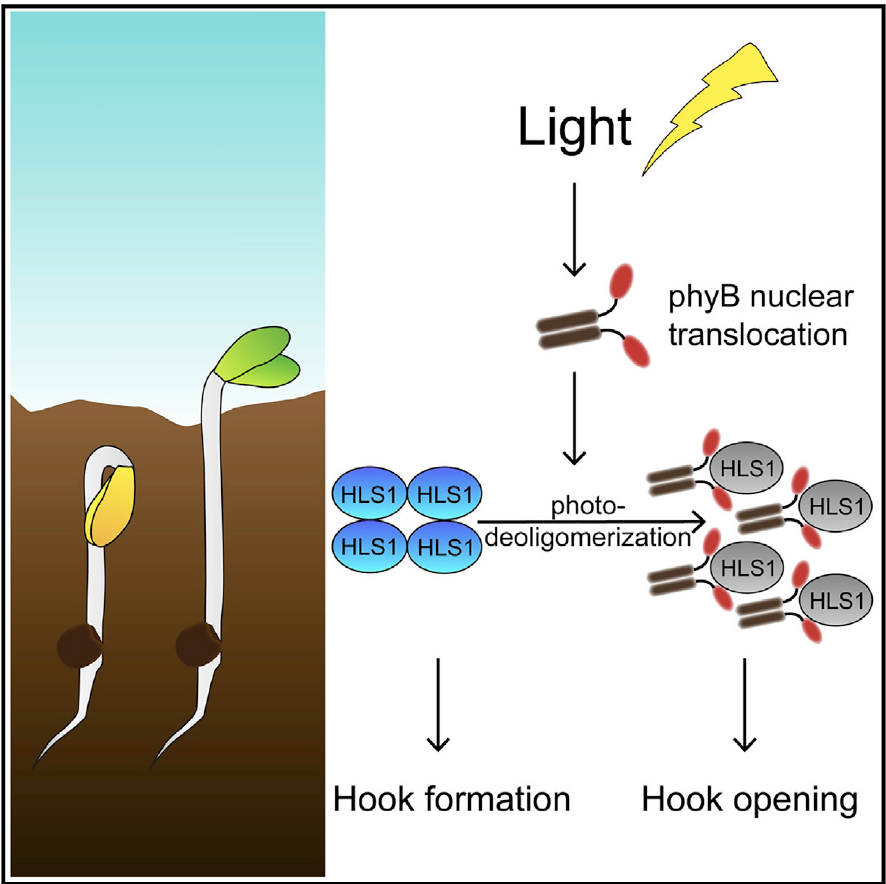博文
Developmental Cell:植物幼苗出土前后顶钩发育状态转变的分子调控机制
||
Oligomerization and Photo-Deoligomerization of HOOKLESS1 Controls Plant Differential Cell Growth
First author: Mohan Lyu; Affiliations: Peking University (北京大学): Beijing, China
Corresponding author: Shangwei Zhong
Apical hook curvature is crucial for buried seedling survival and a superb model for dissecting differential cell growth. HOOKLESS1 (HLS1) is essential for apical hook formation, acting as a hub integrating various external and internal signals. However, its functional mechanism remains unclear. Here, we demonstrate that HLS1 protein is present as an oligomer in the nucleus of dark-grown seedlings. Oligomerization is required for HLS1 activation, as the mutated HLS1 protein abolishing self-association exists as nonfunctional monomers. Upon light exposure, photoreceptor phyB translocates into the nucleus and interacts with HLS1, disrupting the self-association and oligomerization of HLS1 to initiate hook unfolding. Remarkably, genetic expression of nuclear-localized phyB is sufficient to inactivate HLS1, resulting in compromised hook curvature in etiolated seedlings. Together, we conclude that HLS1 protein is active as oligomeric form in darkness and achieves allosteric photo-deactivation upon light, providing intriguing mechanistic insight into the molecular switch for developmental transition.

顶钩弯曲对于保护埋藏在地下的幼苗的存活非常重要,同时也是研究细胞生长分化的理想模型。HLS1对于顶钩的形成是必要的,其主要作用在于整合植物内、外部信号。然而,其具体的功能机制还不是很透彻。本文中,作者发现HLS1蛋白在黑暗条件下的幼苗中主要以寡聚物的形式存在于核中。寡聚化对于HLS1蛋白的激活是必要的,突变的HLS1蛋白不能进行寡聚化,从而以非功能性单体的方式而存在。一旦幼苗突破土壤暴露在光下,光受体phyB就会易位进入细胞核,与HLS1蛋白发生互作,从而打断HLS1蛋白的寡聚化,起始幼苗顶钩的展开。有意思的是,核定位的phyB的遗传表达就足以使得HLS1失活,导致黄化苗的顶钩不能正常弯曲。综上,作者总结道HLS1蛋白在黑暗条件下通过寡聚化激活,发挥功能;而在光下通过变构性导致光失活。本文的研究为植物发育状态转变的分子调控机制提供了新的见解。
通讯:钟上威(http://www.bio.pku.edu.cn/homes/Index/news_cont_jl/17/102.html)
个人简介:2003-2007年,武汉大学,学士;2007-2012年,北京大学,博士;2010-2012年,耶鲁大学,联合培养;2012-2014年,耶鲁大学,博士后。
研究方向:1. 不同土壤环境对植物种子萌发,幼苗生长发育及出土存活的调控机理;2. 出土过程中多种环境因子与植物内源激素共同调控幼苗形态建成的分子网络;3. 叶绿素合成,叶绿体发育,与幼苗抗光氧化损伤分子机制;4. 植物感受土壤机械压力(植物触觉)的蛋白质机器以及机械压力调控植物生长发育的信号传导通路。
doi: https://doi.org/10.1016/j.devcel.2019.08.007
Journal: Developmental Cell
Published online: September 05, 2019

https://blog.sciencenet.cn/blog-3158122-1196898.html
上一篇:Nature Plants:植物花多样化背后潜在发育机制(综述)
下一篇:Nature Communication:IAA5/6/19通过硫代葡萄糖甙调控拟南芥干旱抗性(补2019.09.07)
全部作者的其他最新博文
- • Plant Physiology:CsMADS3促进柑果中的叶绿素降解和类胡萝卜素合成(华中农业大学)
- • Molecular Plant:LBD11-ROS反馈调节作用于拟南芥的维管形成层增殖和次生生长(浦项科技大学)
- • Science Advances:根结线虫通过调控植物的CLE3-CLV1模块,促进侵染进程(日本熊本大学)
- • Nature Communications:油菜素内酯参与植物营养生长期转变的分子机制解析(浙江农林大学)
- • Current Biology:光合作用产生的蔗糖驱动侧根“生物钟”(德国弗莱堡大学)
- • PNAS:花同源异型基因在叶中被抑制、花中被激活的分子机制(南卡罗来纳大学)